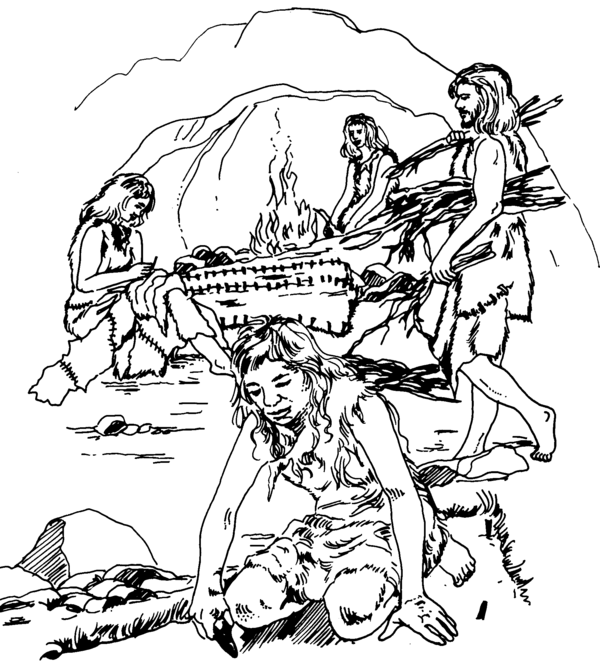| << Chapter < Page | Chapter >> Page > |
Early people developed through different stages. We'll be studying four such stages.
Source 1

Different stages of early man.

Source 3
Each of the above stages is explained below.
a) Australopithecus
The oldest bones that have been discovered are those of Australopithecus . They belong to beings that lived between three and two million years ago and their bones have only been found in South and East Africa. The implements that these early people used probably were stones that they simply picked up. They walked erect and therefore had their hands free. They also used implements made of sticks, leaves and bark. They probably ate mainly vegetable foods.
b) Homo Habilis

Homo ”Habilis” had a brain that was 50% larger than that of Australopithecus – which is why “homo” (man) is added to the name.
The name Homo Habilis implies that they were handy people, because they were the makers of the first stone implements. They mainly lived in the eastern parts of Central Africa, from 2 million years ago to 1,7 million years ago. They produced various stone tools and probably also built stone walls. They also ate much meat. They probably followed a semi-nomadic way of life, living in an area for a while and then moving away to another in search of food.
The world was a dangerous place for them: they were smaller and weaker than the bloodthirsty animals in their surroundings; they did not have claws or fangs; and they could not run as well as the animals. They mostly had to run to the nearest tree to escape danger.
Homo Habilis gradually disappeared from the face of the earth with the passing of time.

c) Homo Erectus
Homo Habilis was succeeded by Homo Erectus , whose bone structure was approximately 25% bigger than that of Homo Habilis . Homo Erectus lived in Southern Africa between 1,7 million and 500 000 years ago. Archaeologists believe that they were able to communicate. They also made stone implements for cutting meat and plant foods and for making sharp tools. They were able to work with wood and discovered how to make fires. They probably used fire to corner animals to kill them for food. They also lived in cave shelters.

Homo Erectus had large teeth, a powerful jaw and a small brain cavity. Their general height was in the region of 1,5 m. As they lived in caves and could use fire, their lives were probably more secure than the lives of their predecessors. With their improved weapons they could even hunt much larger animals like rhinoceroses.
Australopethicus , Homo Habilis and Homo Erectus , of course, are not found any more.

d) Homo Sapiens
Homo Sapiens (which means “wise man”) lived in Africa from 400 000 years ago. These people were just like the modern people that occur all over the world. They had smaller teeth, a narrower jawbone and a better-defined chin. They generally did not follow a nomadic lifestyle.

All the earliest people made use of stones!

Animal skins were sewn together with the use of needles made of bone.

The skins of wild animals were stripped off the animal carcasses, scraped clean and treated to be used as clothing and as coverings for shelters, and as bags for storage.

| Assessment standards(ASe) |
| LEARNING OUTCOME 1: HISTORICAL ENQUIRY- The learner will be able to use enquiry skills to investigate the past and present |
| 1.1 Access the sources |
| 1.2 Use the sources |
| 1.3 Communicate information from sources (reporting)) |
| LEARNING OUTCOME 2: HISTORICAL KNOWLEDGE AND UNDERSTANDING – The learner will be able to demonstrate historical knowledge and understanding |
| 2.1 Understand chronology and time |
| 2.2 Supply reasons why an historical event took place (causes, effects) |
| 2.3 Differentiate between different periods (similarities, differences) |
| LEARNING OUTCOME 3: INTERPRETING HISTORY – The learner will be able to interpret aspects of history |
| 3.1 Be aware of more than one view of the past |
| 3.2 Distinguish between fact and opinion |
| 3.3 Reconstruct the past |
| Criteria | Australopithecus | Homo Habilis | Homo Erectus | Homo Sapiens |
| Period | Lived 3 – 2 million years ago | Lived 2 – 1,17 years ago | Lived 1,7 – 500 000 years ago | Lived 400 000 years ago |
| Origin | South and East Africa | East and Central Africa | Southern Africa | Different places in Southern Africa |
| Appearance | Walked upright | 50% larger brain than its predecessor, small, no claws or fangs | 25% larger brain than its predecessor, strong jaw, small head | Predecessor of modern man. Small teeth, weak jaw, prominent head |
| Lifestyle | Tools: Sticks, bark Food : Plants Dwellings: Nomadic | Tools: Stone Food: Meat Dwellings: Semi-nomadic | Tools: Stone, wood Food: Meat, plants Dwellings: Caves, make fire | Tools: Stone, rock, bone, animal hides Food: Refined food Dwellings : Not nomadic |

Notification Switch
Would you like to follow the 'History grade 7' conversation and receive update notifications?